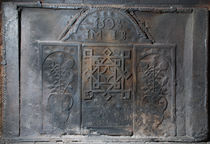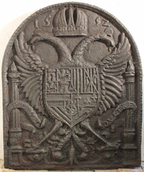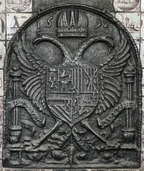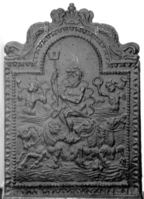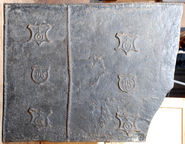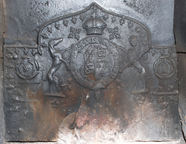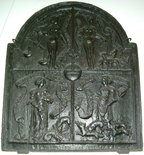-
914
Description: Rectangular shape; twisted rope edging (top and sides) with fillet edging at bottom; cast of a 1598 fireback within a recessed panel, the arch of the original fireback being overlaid with twisted rope and diagonal lengths of rope laid alongside. The original fireback is described as follows: Composite of three elements; central panel has a complex ‘knot’ pattern with a fillet edge; side panel, repeated on either side of the central panel, contains a vase of flowers, possibly stylised thistles, within an arched frame and fillet edge; arched panel above, also with fillet edge, contains the date and inscription; the spandrels of the side panels, and the arched top panel, contain a series of 'bullseye' motifs comprising concentric rings deepening towards the centre.
Notes: The central fireback measures 795mm wide by 735mm high and is from a different casting to that seen at Linchmere, Sussex (no. 475).
Inscription: 1598 / IM IB
- Decoration tags:
- rectangular (shape)
- rope (edging)
- composite
- planklines
- text
- plants
- objects
Manufactured: in the late-16th to early-17th century in the Weald area of England.
Current location: Goddards, Abinger Common, Abinger, Surrey, England.
- Attached to series:
- Armada series
- Composite firebacks
- Garden design types
-
627
Description: Arched shape; cavetto moulded edge; double-headed eagle displayed, a Holy Roman Imperial crown above; in front, a quartered shield; a flaming pillar on each side, a motto scroll entwining each.
Notes: The shield bears the arms of Charles V, Holy Roman Emperor (reigned 1519-1556), king of Spain and nephew of Katherine of Aragon, Queen of England; the pillars are a symbolic representation of the Pillars of Hercules at the Strait of Gibraltar. Some variants of this fireback have a different date (e.g. see no. 1267) or none at all.
Copies of this fireback are known.
Inscription: PLVS OVLTRE [Further Beyond]
Arms: Charles V, Holy Roman Emperor
- Decoration tags:
- rounded arched (shape)
- cavetto (edging)
- whole carved pattern
- individual numbers
- heraldic
- armorial
- royal
- text
Manufactured: in 1592 possibly in the Eifel area of Germany.
Current location: Ashbourne, Derbyshire, England.
- Attached to series:
- Foreign armorial firebacks
-
1267
Description: Arched shape; cavetto moulded edge; double-headed eagle displayed, a Holy Roman Imperial crown above; in front, a quartered shield; a flaming pillar on each side, a motto scroll entwining each.
Notes: The shield bears the arms of Charles V, Holy Roman Emperor (reigned 1519-1556), king of Spain and nephew of Katherine of Aragon, Queen of England; the pillars are a symbolic representation of the Pillars of Hercules at the Strait of Gibraltar. Some variants of this fireback have a different date (e.g. see no. 627) or none at all.
Copies of this fireback are known.
Inscription: PLUS OVLTRE [Further Beyond]
Arms: Charles V, Holy Roman Emperor
- Decoration tags:
- rounded arched (shape)
- cavetto (edging)
- whole carved pattern
- individual numbers
- heraldic
- armorial
- royal
- text
Manufactured: in 1597 possibly in the Eifel area of Germany.
Current location: Owletts, The Street, Cobham, Kent, England.
(part of the National Trust museum group)
- Attached to series:
- Foreign armorial firebacks
-
313
Description: Arched rectangular shape; cavetto moulded edging; date top centre within arch.
Notes: Plain elegant fireback from a late series, probably cast in the south east of England. The crack emanating from the top right corner of the fireback seems to be a weakness on all the recorded examples, and may have caused by thinness of the base board at that point.
Inscription: 1853
- Decoration tags:
- rectangular with round arch (shape)
- cavetto (edging)
- carved stamps
- individual numbers
- text
Manufactured: in 1853 in England.
Current location: Nymans, Staplefield Road, Handcross, Slaugham, West Sussex, England.
(part of the National Trust museum group)
- Attached to series:
- 1850s series
- Date only firebacks
-
110
Description: Arched rectangular shaped central panel with fillet and bead edging, Neptune/Poseidon, holding a trident in his right hand, sitting in a scallop shell drawn by four mythical sea horses, behind are two mermaids; arched rectangular shaped border with ovolo egg and dart edging; above, two symmetrical dolphins with a clam shell between.
Notes: Typical type of firebacks produced in Germany for the Dutch market; the central panel was made separately for insertion into different borders; this border is a relatively simple type. Formerly part of the Ade Collection (from Grove Hill, Hellingly, Sussex).
Copies of this fireback are known.
- Decoration tags:
- 'Dutch' (shape)
- ovolo, egg and dart (edging)
- carved pattern panels
- mythological
- animals
- humans
Manufactured: in the mid- to late-17th century possibly in the Siegerland area of Germany.
Current location: Hastings Museum and Art Gallery, John's Place, Bohemia Road, Hastings, East Sussex, England.
Museum number: HASMG: 1952.51.36 (part of the Hastings Museum museum group)
Citation: Lloyd, N., 1925, 'Domestic Ironwork I', Architectural Review, 58, pp. 58-67.
- Attached to series:
- 'Dutch' Miscellaneous Firebacks
- 'Dutch' Dolphin series
-
176
Description: Probably originally rectangular; twisted rope edging (top and sides); two (originally probably three) panels divided by vertical twisted rope, each containing a rounded shield with fillet edge with 'ihs' (the 'h' crossed), between two cartouche-style shields with fillet edge, bearing a cross rising from two concentric rings.
Notes: The overtly religious symbolism may indicate a pre-Reformation or Marian date. The christogram, 'ihs', derived from the first three letters of 'IESUS' in Greek, was first noted in England in the 14th century. The cross rising from the rings may be intended to indicate christian dominion over the globe. Possibly as much as the right third of the fireback is missing. The fireback is believed to have been in Robertsbridge Abbey.
Inscription: ihs ihs
- Decoration tags:
- rectangular (shape)
- rope (edging)
- simple stamps
- carved stamps
- heraldic
- text
Manufactured: in the early-16th century possibly in the Weald area of England.
Current location: Hastings Museum and Art Gallery, John's Place, Bohemia Road, h, East Sussex, England.
Museum number: HASMG: 1914.38 (part of the Hastings Museum museum group)
- Attached to series:
- Religious firebacks
-
189
Description: Rectangular with an ogee arch; twisted rope edging (top and sides); line of small fleurs-de-lys around the top and sides, inside the edging; Tudor rose inside each top corner (overstamped on the left); below each rose an escarbuncle of twisted rope with fleur de lys terminals (understamped); top centre, a Tudor royal shield within an oval garter - HONE SOVT QUEY MAL Y PENSE - with greyhound and lion supporters, and crown above; cross of small fleurs inclined to each side of the crown; inverted 'Y' shape in twisted rope below each supporter, a fleur at the top end of each.
Notes: An oft-used achievement of arms; twisted rope with fleur de lys terminals are seen on other firebacks from the same source; it is a form paralleled on firebacks from the Champagne area of France. The escarbuncle was the principal charge on the arms of the Duchy of Cleves, the same charge on this fireback possibly associating it with the brief marriage of Henry VIII and Anne of Cleves.
Inscription: HONE SOVT QUEY MAL Y PENSE
Arms: Tudor royal (prob. Henry VIII)
- Decoration tags:
- rectangular with ogee-arch (shape)
- rope (edging)
- carved stamps
- heraldic
- armorial
- royal
- text
- objects
Manufactured: in the mid- to late-16th century possibly at Pounsley Furnace, Framfield in the Weald area of England.
Current location: in private hands, Hatfield, Hertfordshire, England.
- Attached to series:
- Pounsley series
- Fleur rope terminal series
- Tudor royal armorial firebacks
-
441
Description: Sub-rectangular; edged with a repeated length of helically-turned dowel (top and sides); apparently random arrangement of same piece of dowel repeated ten times, including a saltire and cross.
Notes: Apart from the Christian significance of the cross, the other arrangements of rope lengths may be apotropaic in their purpose, the double V being a possible invocation of the Virgin. The blemishes at the base are caused by the casting sand being disturbed by the pouring of the metal.
- Decoration tags:
- rectangular (shape)
- rope (edging)
- simple stamps
- apotropaic
- objects
Manufactured: in the 16th century in the Weald area of England.
Current location: Anne of Cleves House, Southover High Street, Lewes, East Sussex, England.
Museum number: LH000.799 (part of the Sussex Archaeological Society museum group)
Citation: Dawson, C., 1903, 'Sussex Iron Work and Pottery', Sussex Archaeological Collections, 46, pp. 1-54.
Citation: Gardner, J. S., 1898, 'Iron Casting in the Weald', Archaeologia, 56, 1, pp. 133-164.
- Attached to series:
- Rope design firebacks
-
989
Description: Arched rectangular shape with fillet edging; within an arched rectangular border alternating repeated acanthus leaves, and a floral cartouche, a heart-shaped shield of the royal arms of France, surmounted by a royal crown and within splayed olive branches.
Arms: France Royal
- Decoration tags:
- rectangular with round arch (shape)
- fillet (edging)
- whole carved pattern
Manufactured: in the late-17th century in France.
Current location: not known.
- Attached to series:
- Foreign armorial firebacks
-
753
Description: Arched rectangular shape; parallel astragal and fillet edging; four panels divied by fillets, an orb with a cross at the intersection; top left, naked female figure holding scales in her right hand, a scroll bearing an inscription above her and to her left and right; top right, a naked female figure holding a hawk in her right hand and leading two dogs with her left hand, a scroll bearing an inscription above her and to her left and right; bottom left, a clothed female figure, at her feet a fox attacking a serpent, a scroll bearing an inscription above her and to her left and right; bottom right, a clothed female figure, at her feet hounds chasing and attacking another animal, a scroll bearing an inscription above her and to her left and right.
Notes: The figures (clockwise from top left) probably represent Justice and Vigilance (both naked), Indifference and Perfidy (both clothed).
Copies of this fireback are known.
Inscription: ..T IS V EN SCHADE DAT TROV IS LICHTER DAN PLVME / ICH JAG OM DIE VINDE OFT ICH TROV KOND FINDEN / TROV IS DOET ONTROVE VERDT VERFAVLEN / ONTOVE LOEPT OVER ..AL
- Decoration tags:
- rectangular with round arch (shape)
- astragal & fillet (edging)
- whole carved pattern
- planklines
- pictorial
- allegorical
- text
- humans
Manufactured: in the late-16th century possibly in the Wallonia area of Belgium.
Current location: Victoria & Albert Museum, Cromwell Road, Kensington & Chelsea, Greater London, England.
Museum number: 142.1898 (part of the Victoria & Albert Museum museum group)
- Attached to series:
- Virtues and Faults firebacks
